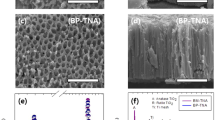Abstract
In recent years, the search for environmentally friendly alternative energy sources with reduced carbon footprints has increased. The coupling of photovoltaic power sources with advanced electrolysis systems for hydrogen production via water splitting using organic contaminants as sacrificial electron donors has been considered to a be viable alternative. In this report, we demonstrated the feasibility of a scaled-up rooftop prototype of the proposed hybrid photovoltaic-electrolysis system, which utilizes semiconductor nanoparticles coated on to metal substrates as electrodes for the generation of hydrogen coupled with the oxidation of wastewater. Application of an anodic bias of >2.0 V to bismuth-doped TiO2 (BiO x –TiO2) on Ti metal anodes with a sequential under-coatings of nanoparticulate SnO2, IrO2, Ta2O5, and Bi2O3 results in the electrochemical degradation of a variety of organic chemical contaminants in water (i.e., rhodamine B (Rh.B), methylene blue (MB), salicylic acid, triclosan, and phenol) and actual wastewater from a chemical manufacturing plant, while at the same time, molecular hydrogen is produced at stainless steel (SS) cathodes. The kinetics of the anodic substrates oxidation is investigated as a function of the cell current (I cell), substrate concentration, and background electrolyte composition (e.g., NaCl, Na2SO4, or seawater). Average current efficiencies were found to be in the range of 4–22 %, while the cathodic current and energy efficiencies for hydrogen production were found to be in the range of 50–70 % and 20–40 %, respectively.








Similar content being viewed by others
References
Ahmad GE, El Shenawy ET (2006) Optimized photovoltiac system for hydrogen production. Renew Energ 31:1043–1054
Anglada A, Urtiaga A, et al (2009) Contributions of electrochemical oxidation to waste-water treatment: fundamentals and review of applications. J Chem Technol Biotechnol. doi:10.1002/jctb.2214
Bonfatti F, Ferro S et al (2000) Electrochemical incineration of glucose as a model organic substrate—II. Role of active chlorine mediation. J Electrochem Soc 147:592–596
Cabeza A, Urtiaga AM et al (2007) Electrochemical treatment of landfill leachates using a boron-doped diamond anode. Ind Eng Chem Res 46:1439–1446
Chen GH (2004) Electrochemical technologies in wastewater treatment. Sep Purif Technol 38:11–41
Comninellis C, Nerini A (1995) Anodic-oxidation of phenol in the presence of NaCl for waste-water treatment. J Appl Electrochem 25:23–28
Comninellis C, Pulgarin C (1991) Anodic-oxidation of phenol for waste-water treatment. J Appl Electrochem 21:703–708
DOE (2008) International energy outlook 2006; DOE/EIA = 0484(2008). Energy Information Administration
Gibson TL, Kelly NA (2008) Optimization of solar powered hydrogen production using photovoltaic electrolysis devices. Int J Hydrogen Energy 33:5931–5940
Hollmuller P, Joubert JM et al (2000) Evaluation of a 5 kW(P) photovoltaic hydrogen production and storage installation for a residential home in Switzerland. Int J Hydrogen Energy 25:97–109
Iniesta J, Michaud PA et al (2001) Electrochemical oxidation of phenol at boron-doped diamond electrode. Electrochim Acta 46:3573–3578
Jiang JY, Chang M et al (2008) Simultaneous hydrogen production and electrochemical oxidation of organics using boron-doped diamond electrodes. Environ Sci Technol 42:3059–3063
Juttner K, Galla U et al (2000) Electrochemical approaches to environmental problems in the process industry. Electrochim Acta 45:2575–2594
Kraft A (2007) Doped diamond: a compact review on a new, versatile electrode material. Int J Electrochem Sci 2:355–385
Lehman PA, Chamberlin CE et al (1997) Operating experience with a photovoltaic-hydrogen energy system. Int J Hydrogen Energy 22:465–470
Montanaro D, Petrucci E (2009) Electrochemical treatment of Remazol Brilliant Blue on a boron-doped diamond electrode. Chem Eng J 153:138–144
Montanaro D, Petrucci E et al (2008) Anodic, cathodic and combined treatments for the electrochemical oxidation of an effluent from the flame retardant industry. J Appl Electrochem 38:947–954
Murugananthan M, Yoshihara S et al (2007) Electrochemical degradation of 17 beta-estradiol (E2) at boron-doped diamond (Si/BDD) thin film electrode. Electrochim Acta 52:3242–3249
Panizza M, Barbucci A et al (2007) Electrochemical degradation of methylene blue. Sep Purif Technol 54:382–387
Park H, Vecitis CD et al (2008a) Solar-powered production of molecular hydrogen from water. J Phys Chem C 112:885–889
Park H, Vecitis CD et al (2008b) Solar-powered electrochemical oxidation of organic compounds coupled with the cathodic production of molecular hydrogen. J Phys Chem A 112:7616–7626
Park H, Vecitis CD et al (2009) Electrochemical water splitting coupled with organic compound oxidation: the role of active chlorine species. J Phys Chem C 113:7935–7945
Petrucci E, Montanaro D (2011) Anodic oxidation of a simulated effluent containing Reactive Blue 19 on a boron-doped diamond electrode. Chem Eng J 174:612–618
Shen ZM, Yang J et al (2005) Dual electrodes oxidation of dye wastewater with gas diffusion cathode. Environ Sci Technol 39:1819–1826
Srinivasan S (2006) Fuel cells: from fundamentals to applications. Springer, New York
Urtiaga A, Rueda A et al (2009) Integrated treatment of landfill leachates including electrooxidation at pilot plant scale. J Hazard Mater 166:1530–1534
Vaghela SS, Jethva AD et al (2005) Laboratory studies of electrochemical treatment of industrial azo dye effluent. Environ Sci Technol 39:2848–2855
Vlyssides AG, Karlis PK et al (2002) Electrochemical treatment in relation to pH of domestic wastewater using Ti/Pt electrodes. J Hazard Mater 95:215–226
Weres O (2009) Electrode with surface comprising oxides of titanium and bismuth and water purification process using this electrode, US 7494583 B2
Acknowledgments
We are grateful to the Bill and Melinda Gates Foundation for support of our solar toilet project under the Reinventing the Toilet Project, Grant: OPP1037491 “Development of a Self-Contained, PV-Powered Domestic Toilet and Wastewater Treatment System.”
Author information
Authors and Affiliations
Corresponding author
Additional information
Special Issue Editors: Mamadou Diallo, Neil Fromer, Myung S. Jhon
This article is part of the Topical Collection on Nanotechnology for Sustainable Development
Rights and permissions
About this article
Cite this article
Choi, J., Qu, Y. & Hoffmann, M.R. SnO2, IrO2, Ta2O5, Bi2O3, and TiO2 nanoparticle anodes: electrochemical oxidation coupled with the cathodic reduction of water to yield molecular H2 . J Nanopart Res 14, 983 (2012). https://doi.org/10.1007/s11051-012-0983-5
Received:
Accepted:
Published:
DOI: https://doi.org/10.1007/s11051-012-0983-5




